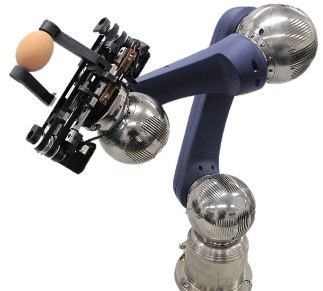Robotic Gripper with Variable Stiffness Actuators
Web Published:
10/12/2020
A robotic gripper with variable stiffness actuators improves the safety and robustness of the grasp and enhances dynamic manipulation.
The reliable grasping and handling of objects is essential to industrial and service robots for physical human-robot interaction (pHRI). Moreover, safety becomes an important issue when a robot needs to handle fragile or sharp objects in uncertain and dynamic environments. Considerable research effort has been directed towards the development of methods for increasing human safety in pHRI. In active control, compliant interaction with the environment is mimicked by using sensor data and force control of rigid joints. Active controls have a number of limitations in terms of sensor failure, bandwidth, and cost of instruments.
A passive variable stiffness actuator (VSA) device to control and adjust the position and compliance — or “give” — of the “fingers” on a robotic gripper has been developed. System compliance is generated by using permanent magnets as the nonlinear springs. The device estimates contact forces without force sensors to reduce bulk on the gripper assembly. It provides for low friction, compactness, and an improvement of the robustness when inadvertent collisions occur. The device’s compliance not only enables it to pick up delicate objects, but also ensures symmetrical movement and a symmetrical return to equilibrium position, without dropping or damaging the grasped object. The design could be expanded to have more degrees of freedom, such as a three (or more) fingered gripper. The machine controller compensates for gravity, dynamic motion, and friction.

- Provides controllers with contact force measurement for each finger of the gripper individually.
- Controls robustness of grasping when an inadvertent collision occurs, for example, due to robot arm movements.
- Improves safety in human-robot interactions.
- Adaptable to most robots.
- Automotive
- Electronic Packaging
- Food Industry
US Patent 11,607,817 issued March 21, 2023
Prototype demonstration.
Available for licensing.
http://www.acsu.buffalo.edu/~ehsanesf/IEEE-TIE-2019.pdf
Futurity Article and Video
Patent Information:
| App Type |
Country |
Serial No. |
Patent No. |
Patent Status |
File Date |
Issued Date |
Expire Date |
|